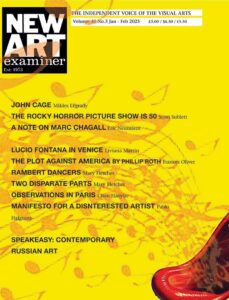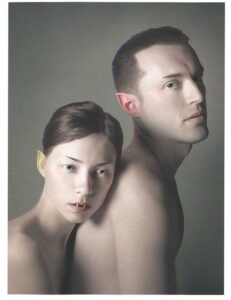Isabella Chiadini
Bestiary was a medieval book filled with illustrations of real and imaginary animals. The Bestiari that the Catalan artist Carlos Casas has put on in Venice although inspired by such books, is a little bit different.
This is the story of endless research. Of works of art that come to life thanks to the reading of books that, in turn, revealed the existence of more books. Reverberating with precious words one to another, one echo to another; just as happens when we are researching into something.

The volume here is Anselm Turmeda’s Disputa de l’Ase (Dispute of the Donkey), written in 1417. Carlos Casas stumbled upon it because it was mentioned as being influenced by a classic Islamic text, The Case of the Animals versus Man Before the King of the Jinn that he read during his research for his project Avalanche (2005-ongoing).
Disputa de l’Ase is one of the first books written in Catalan. Striking for Carlos Casas is how this middle-age text presents the animal world. The book narrates a court taken by a group of animals tired of being deemed inferior by a friar, Fra Anselm, who has preached over 100 times that “the children of Adam are more noble, excellent and of greater dignity than … animals.” A donkey (not by chance) is chosen as a spokeperson to face Fra Anselm. Casas says that the modernity and sarcasm of Turmeda’s vision “read to me as a pure critique to the established rules and anthropocentrism, revealing an incredible sensibility of the animal world and other species. Turmeda appears to be making a connection to non-humans while also being responsible, as a human, for the demise of the animal world. This connected to my struggle as an artist to work towards the protection and celebration of other species and the natural world”.
Casas’ work has always delved into the connections between humans and other species using the latest technology to reproduce sound because sound is his channel “to connect to and ultimately to transform the mentalities that stop our sustainable advancement as species”. Turmeda’s book was the perfect entry point to expand Casas’ research about a possible cross-species dialogue based on hearing and reciprocal understanding. “A sort of platform for our umwelts to superimpose and interact, and let our common and distant pasts do the rest”.
The national Parks of Catalonia were the place to accomplish the project and Casas had to decide which animals he would record and which places, in particular, he would film. The original idea to work only with autochthonous species was scrapped because it limited the possibility of including animals whose role, in people’s imaginary, is crucial. Hence, the guiding criterion was “mostly based on a perceptual interest, each species was selected in relation to the sounds they produce and what they represent”.
The exhibition is Carlos Casas’ own bestiary: a work that contains a group of animals “representing and encompassing the whole spectrum of sounds from elephants and dolphins to bats and bees. Casas also underlines that he wanted “to expose the public to all possible sound waves and colour specters”. Seven animals from Catalonia and beyond have been recorded in their natural habitats and loudspeakers reproduce their sound and frequency. They are bats, bees, dolphins, donkeys, elephants, parrots and snakes. And that’s not all because the participation of the human voicof Marina Herlop, was conceived as “a way to introduce the idea of a new species, of an evolved human, able to communicate with other species”.
The exhibition space is astonishing in that we get to know a company of animals. The filmed images and the sound recording technique through spatialization, the ambisonic system or 3D sound, reveal the magnificence of the parks of Catalonia and the guiding force of sound as a physical element; we can finally hear its various dimensions through tones ranging from infrasounds to ultrasounds. This is where, as Casas says, a whole universe unfolds; perhaps we reconnect to our own animality thanks to the chance of slowly deciphering these animals’ messages. We will hear, and we will perceive, the call of the donkeys, of the parakeets and of the other five non-humans as a song that speaks to us. We will discover an interspecies connection, given that it is through the physical reaction of our body, either to the buzz, to the shriek or to the rumbles, that a kind of communication can begin. The sounds that Casas intercepted and edited have such a level of purity and quality that they cannot just pass right besides us, which is our usual listening mode when hearing an animal. The sounds of the non-humans, and the related images of the sounds, slip so much under the skin that there is almost no distinction between us and those animals. Casas, using the ambisonic system technology, generates colours and shapes that melt into each other in a seamless continuum. The appearance is almost liquid and soft, while still retaining a certain consistency; sometimes not definable in our chromatic scale. That’s how we are immersed into these sounds visions; we can see through the sounds and we can hear through the images. It is a language that simply reveals itself arousing, expanding and transforming our modes of perception.
According to the sound recordist and musician Chris Watson, who works with some scientists at the University of St Andrews, and collaborates with Casas, the concept of the different “temporal resolution” between human beings and non-humans is the node that they must keep exploring and developing in order to get an effective interspecies comprehension. Chris Watson says that “the classic example is that of a wren singing. That wren can produce 64 notes in an 8-second song phase. If you slow it down four times you can see and hear the individual notes”. Carlos Casas says that Bestiari, the installation, is a harmonious trans-sensorial station (haven) that “strives to induce a state of vibrational static diffusion and sensing”. A condition he coins ‘Physiological Static Perception’, PSP: an orchestrated experience to foster understanding and connection with the environment … Bestiari serves as a remedy for speciesism, an exhibition for comprehending the world as a symbiotic organism. It envisions a future where cross-species energy exchange achieves equilibrium, fostering unity between sentient and non-sentient matter. Bestiari’s mission extends to the acknowledgment that perception is not just passive observation but “an active force capable of shaping and manipulating the world”.

To Casas the apparatus of the exhibition is crucial to induce a sort of hypnagogic dream inspired by Turmeda’s Fra Anselm, when he falls asleep and wakes up with the capacity to understand animal speech.
Carlos Casas told me that the sound is the only remaining lingua franca. Namely, if we want to save ourselves – us and all the other animals – we must continue on the path of connecting with the non-human world. What are they saying? Is there anything in particular they want to tell us? Are they afraid of us? Putting us all on the same level we may experience a real new way of life.
Unfortunately my enthusiasm faded away when, just a few hours after seeing Casas’ installation, I happened to hear the Italian Minister of Agriculture Francesco Lollobrigida declaring “Humans are the only sentient beings on Earth. Only humans can convert the scientific data and findings into actions that would lead to rebalancing the ecosystem”. This would seem to be the criterium for defining living beings. It’s not quite clear what the Minister means especially in his second neboulous senten. However his anthropocentric vision is clear. There is no other space but for an arrogant, overbearing, omnipotent, inexorably lonely, human being; on the run, in my opinion, towards ruin. I cannot think of any other image than this. It is likely that many people would agree with the Minister. And, paradoxically, it is likely that evidence-based scientific data may be branded whacky fantasies.
I must say though that my feeling of sadness and discouragement wouldn’t last. The magnificent power of what I had the chance to hear and see was all it took to regain my hope. Not a passive one but rather a kind of active hope, and confidence too. Like the ones that Carlos Casas, together with the curator of the Venice installation Filipa Ramos, and many of their friends and collaborators, nurture through their research and their consequent art and lifestyle. Casas told me “I thought I’d invite a group of animals to collaborate in the realization of this project”. He said it with such an authentic naturalness and humility that I was impressed.
It’s what I mean by talking about practicing an active hope. This thought is a manifesto and at the same time an action put into practice through art.
Note: Filipa Ramos, the curator, has edited a publication that brings together a series of newly commissioned texts that accompany visitors among the peculiarities that emerge from Bestiari. Besides, as a tribute to Turmeda’s writing, seven authors – the anthropologist and ecofeminist Yayo Herrero or the philosopher Emanuele Coccia, to name two – with an interest in ecology and nature’s cultures were commissioned to write a dialogue with one of the animals of the Bestiari. Moreover art historian Pol Capdevila gives his account of the events that will accompany the exhibition: a debate will take place about the language of some of Catalonia’s animal species. Specialists in the language of birds, bats and cetaceans, among others, will be invited to talk and show how new advances in audio recording of these species have been transforming our understanding of their way of living and relating. In addition the artist Carlos Casas, the curator Filipa Ramos and the sound artist Chris Watson will organize a sound exploration workshop linked to the sounds of Bestiari.
Bestiari Catalonia in Venice Carlos Casas. Curated by Filipa Ramos Institut Ramon Llul. La Biennale di Venezia 60. Esposizione Internazionale d’Arte Collateral Events April 20 – November 24, 2024 Docks Cantieri Cucchini, Venice

